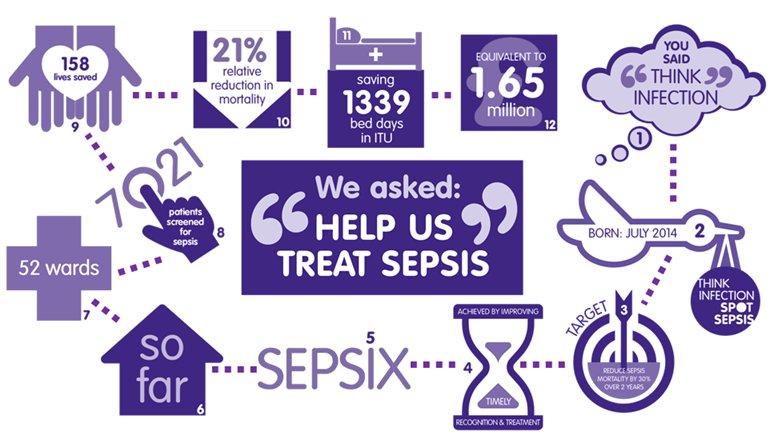Global problem, local action Tackling sepsis in Northumbria
13 September 2017

Sepsis is a time-critical condition that can lead to organ damage, multi-organ failure, septic shock and eventually death. In the UK, it is conservatively estimated that 150,000 cases of sepsis occur every year, resulting in some 44,000 deaths.
According to a report released by the Parliamentary Health Service Ombudsman in 2014, better sepsis care could save 13,500 lives every year and save the NHS £314m annually.
110,000 people were admitted to Northumbria NHS Foundation Trust’s hospitals in 2013, 2,302 of these with sepsis. Of those admitted, 657 died, a figure considerably higher than the 609 expected deaths, and which led to sepsis treatment being identified as a priority for the Trust.
We were delighted to then secure the Health Foundation’s support for a sepsis project, as part of their Closing the Gap in Patient Safety programme.
Our project, called Think Infection Spot Sepsis, aimed to reduce the number of sepsis-related deaths by 30% in two years, by improving the timely recognition and treatment of sepsis in the emergency care department. This was done by systematically screening patients for sepsis, and where identified, treating them using the Sepsis Six care bundle. Sepsis Six consists of three diagnostic and three therapeutic steps, such as taking blood cultures and administering certain antibiotics, to be delivered within one hour of the initial diagnosis of sepsis.
Today, 13 September, marks World Sepsis Day, uniting people around the world in the fight against sepsis. Reflecting on our own experience, what did we do, what did we learn and what impact did we have?
We knew that securing the motivation and support of clinical teams was critical to successful implementation. Fundamental to this was a coherent communication strategy, which from the launch event onwards captured hearts and minds with simple messages to increase awareness of the symptoms of sepsis. The launch event served as an ideal platform to help staff realise that the failure to recognise and start early treatment of sepsis was a considerable problem in the Trust. Patients and families shared powerful stories which reinforced the value of early recognition and treatment.
The introduction of an Infection Screening Tool (IST) assisted in education and provided a clear pathway for the interventions to be taken when sepsis was identified. The IST also promoted team coherence, not least by legitimising nurses’ role in escalating patients and initiating treatment using Sepsis Six. This constituted one of the biggest changes in practice as previously nursing staff had simply reported deterioration and awaited instructions or action by the doctors.
A surprising discovery was the power of the IST to directly impact on patient outcomes. Raising staff awareness to the possibility of sepsis through reliable screening ultimately made a greater contribution to reducing mortality rates than Sepsis Six. Patients assessed using the screening tool were shown to have a 21% lower mortality rate than those where the tool had not been used.
Weekly walk-arounds by project leads enabling two-way communication with clinical staff, locally-based education by ‘sepsis champions’ using standardised resources, and daily measurement and feedback to staff about compliance with the use of the sepsis six bundle, were all important factors in the success of the project.

Perhaps the greatest legacy of the project is the Trust-wide recognition of the role of back of house teams, such as the communication department and the information team, in improving quality, safety and patient care.
Ultimately our Think Infection Spot Sepsis campaign was implemented in 52 wards across the Trust with over 7,000 patients screened.
The project resulted in an increase in patients receiving the Sepsis Six interventions within the first hour, from less than 10% to approximately 60% in 15 months: saving some 158 lives. The subsequent avoidance of 1,339 critical care bed days over a two-year period translates to a financial saving of approximately £1.65m.
Annie Laverty is the Director of Patient Experience and Quality at Northumbria Healthcare NHS Foundation Trust, and Health Foundation Generation Q Fellow
Work with us
We look for talented and passionate individuals as everyone at the Health Foundation has an important role to play.
View current vacanciesThe Q community
Q is an initiative connecting people with improvement expertise across the UK.
Find out more

